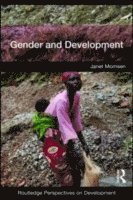
- Format
- Häftad (Paperback / softback)
- Språk
- Engelska
- Antal sidor
- 304
- Utgivningsdatum
- 2009-12-02
- Upplaga
- 2 New edition
- Förlag
- Routledge
- Illustrationer
- 20 Line drawings, black and white; 48 Halftones, black and white; 16 Tables, black and white; 68 Ill
- Dimensioner
- 235 x 155 x 10 mm
- Vikt
- Antal komponenter
- 1
- ISBN
- 9780415775632
- 514 g
Gender and Development
Kundrecensioner
Fler böcker av författarna
-
Bridging Worlds - Building Feminist Geographies
Anindita Datta, Janet Momsen, Ann M Oberhauser, Anindita Datta
-
Women and Development in the Third World
Janet Momsen
-
Different Places, Different Voices
Vivian Kinnaird, Janet Momsen
-
Tourism and Agriculture
Rebecca Torres, Janet Momsen, Rebecca Torres, Janet Momsen
Recensioner i media
"This is the most useful and comprehensive volume to have been published in the field of gender and development. The intellectual rigour combined with accessibility and engagement makes it a critical read for students, researchers, academics and policy makers. Indeed anyone who wishes to gain an in-depth yet wide ranging understanding of key contemporary global issues within the gender and development arena should read this book." --Suzanne M Clisby, University of Hull, UK "Gender and Development in an unrivalled introductory text which clearly outlines how and why women's and men's experiences of development processes vary over time and space. Janet Momsen draws together theoretical material, case studies and analyses of policy in a highly effective and accessible manner drawing on her considerable experience in the field." -Katie Willis, Royal Holloway, UK "To fully appreciate what gender and development is all about and to be abreast of the theoretical approaches and methods, read this book. Janet Momsen has fulfilled the need for a clear-sighted jargon-free text on the subject that is accessible by students as well as the practitioners involved with gender and development regardless of their discipline, organisation or profession." -Kuntala Lahiri-Dutt, Fellow, College of Asia & the Pacific, The Australian National University, Australia "...a timely and useful research and teaching tool" -Sharon Ladenson, Michigan State University, USA
Övrig information
Janet Momsen recently retired from the University of California, Davis as Professor of Geography although she is still working with several postgraduate students there. She is now affiliated with the University of Oxford as a Senior Research Associate in the School of the Environment and in International Gender Studies. She has taught at several universities in England, in Canada, Brazil, Costa Rica and in the USA and carried out field research in the Caribbean, Brazil, Costa Rica, Ghana, Mexico, China, Bangladesh and Hungary.
Innehållsförteckning
1. Introduction: Gender is a Development Issue 2. Demography and Migration 3. Reproduction 4. Gender, Health and Violence 5. Gender and Environment 6. Gender in Rural Areas 7. Gender and Urbanization 8. Globalization and Changing Patterns of Economic Activity 9. How Far Have We Come?
Du kanske gillar
-
Peak Human
Johan Norberg
Häftad -
Peak Human
Johan Norberg
Inbunden
